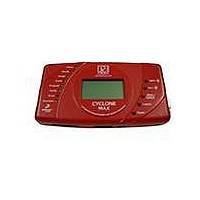CYCLONEMAX Freescale Semiconductor, CYCLONEMAX Datasheet - Page 69

CYCLONEMAX
Manufacturer Part Number
CYCLONEMAX
Description
CYCLONE MAX FLASH PROGRAM
Manufacturer
Freescale Semiconductor
Series
ColdFire®r
Type
FLASHr
Specifications of CYCLONEMAX
Contents
Programmer/Debugger
Positions/sockets
1
Description/function
Programmer, Debugger
Silicon Family Name
MPC5xx
Core Architecture
Coldfire, Power Architecture
Core Sub-architecture
Coldfire V2, Power Architecture
Rohs Compliant
Yes
For Use With/related Products
MPC5xx / 55xx
Lead Free Status / RoHS Status
Lead free / RoHS Compliant
Available stocks
Company
Part Number
Manufacturer
Quantity
Price
Part Number:
CYCLONEMAX
Manufacturer:
FREESCALE
Quantity:
20 000
8
8.1
Cyclone MAX User Manual
ETHERNET PORT CONFIGURATION
Note:
Network Architecture
This chapter describes the mechanism used by the Cyclone MAX device to
transact data over an Ethernet network. It primarily focuses on the User
Datagram Protocol (UDP), which is a popular method for sending data over a
network when the speed of a data transaction is of more concern than the
guarantee of its delivery. The Cyclone takes advantage of the UDP protocol’ s
penchant for speed, and adds an extra layer of logic to guarantee the delivery
of UDP packets in order to offer a best-of-both-worlds solution.
Users who are familiar with ethernet protocol may wish to skip ahead to
Section 8.6 - Cyclone IP Setup Utility User Interface (ConfigureIP).
Before delving into the innards of Ethernet message passing, it is prudent to
briefly describe the different network architectures in use today, and how they
pertain to the operation of the Cyclone Max. Computers are, of course,
connected to one another through intermediary devices in order to form
networks. There are several classes of these intermediary devices, but they
generally fall into one of the following three groups:
a Hub. A Hub is a device with several ports that are used to connect
multiple computers together. It is a repeater device – a Hub simply copies
incoming data on one of its ports as data outgoing on the other ports. In
this manner, if there are four computers connected through a Hub, and if
the first computer is sending data to the second computer, then the third
and the fourth computers will also receive an identical copy of the data.
Hubs are usually used to set up a small Local Area Network (LAN), which
may have on the order of 10 to 20 computers.
onto every available port, quickly becomes inefficient for larger sized
networks. For this reason, a larger sized LAN employs the usage of
Switches instead of Hubs. A Switch is essentially a smart Hub, in that it
limits the input and output of data to the two transacting computers.
Hubs
At the most basic level, computers are connected to one another through
Switches
The aforementioned types of process, where the data is simply replicated
Routers
Larger networks, such as Wide Area Networks (WANs), or the Internet for
CYCLONE MAX
65












